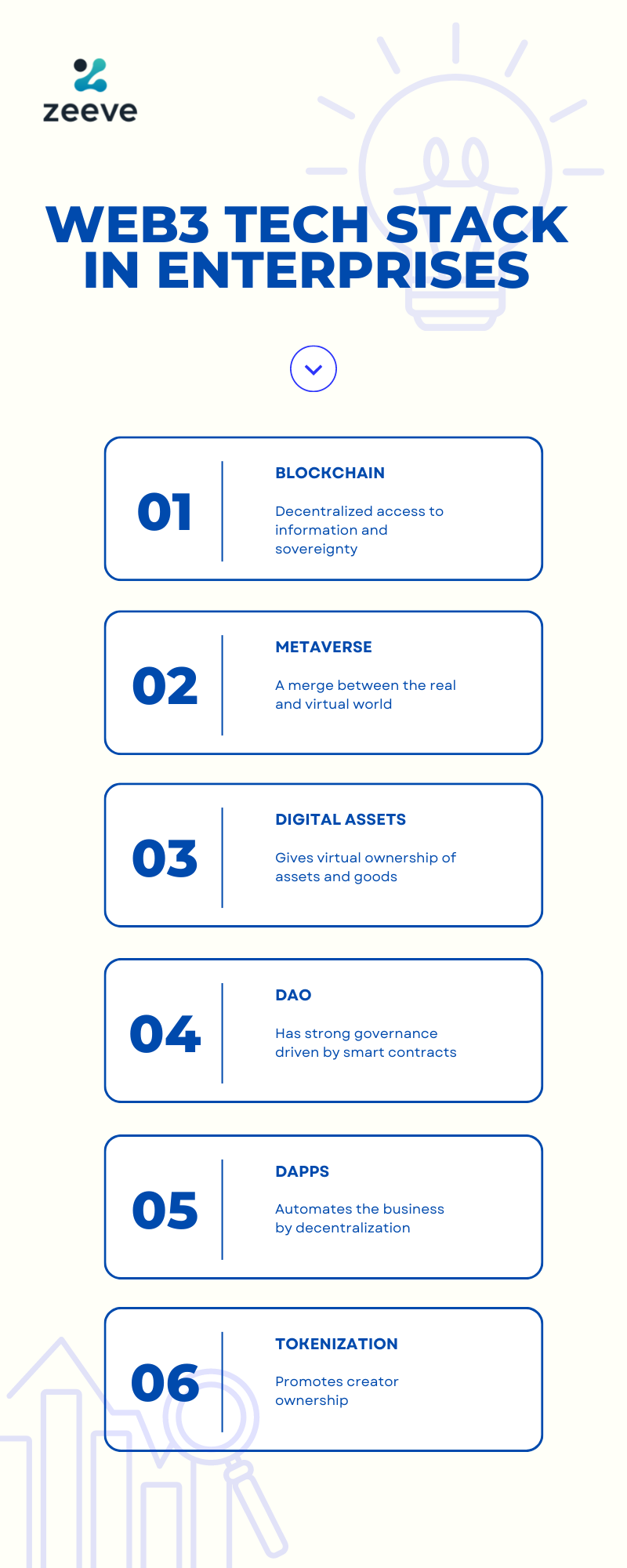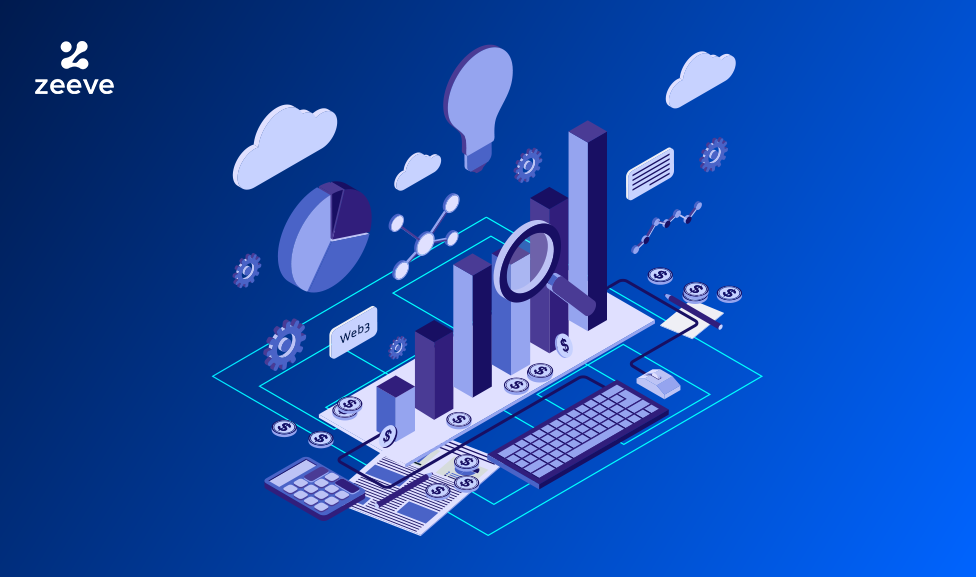One of the top secrets of any enterprise reaching new heights of success is experimenting and deploying the latest technology. As a result, enterprises are finding new ways to present themselves to boost customers’ experience, manage work, and be value-driven. The strategy is to become adaptable to new technology and find sustainable ways for growth.
Adjusting towards the new advances in the digital space gives more power to enterprises. The integration of the Web3 stack will strengthen the core of the businesses. For a couple of years, more and more companies have been readily employing Web3. Though the Web3 technology wasn’t called to be transformative a few years back. However, 3.1 trillion enterprises by 2030 will become part of Web3, according to Gartner.
Web2 promoted the digital payment system and, in some cases, the buy now, pay later services. Currently, the main focus for enterprises is to retain users and become innovative leaders. In the upcoming decades, Web3 adoption by enterprises will allow them automation, transparency, and better interaction with consumers.
In the blog, we will walk you through the Web3 stack and its adoption by enterprises. Further will have a look at how Web3 helps enterprises in automation.
What is the Web3 stack?
Web3 stack follows a “read-write-own” format where the users are owners as well. The ownership happens because of the incentives. A tech stack refers to all the technology employed to form an application. The Web3 tech stack comprises — Blockchain, Smart contracts, development environment, frameworks, UI/UX, and user identity management.
Among this, blockchain in Web3 is the foundation of the tech stack and blockchain-driven businesses are on the rise. $19 billion will be spent on blockchain-based enterprises by 2024.
Sometimes even the best software isn’t able to give results. But with Web3, the transactions will get decentralized and will remain secure. Due to blockchain technology, the P2P transaction occurs without any third party. The transactions are saved on a block. All the team members( of a company) and consumers receive a copy of the block. The newly formed block is validated and further added to the chain. Finally, the transaction is completed.
Why should Enterprises Support the Web3 tech stack?
Big companies are moving towards Web3 because they know the next evolution of the Internet is effective to understand user behaviour, provide customized services and enhance earnings. Here are the three major benefits for companies planning to adopt Web3:
Ownership
Digital ownership is taking a new form nowadays. Your company’s logo, website, and even the content are classified as digital assets. The current trend is of NFTs. Companies such as Nike, Shopify, McDonald etc., are leveraging the trend smartly. The trend may change in the future, but the concept of digital assets is here to stay. In fact, the Metaverse will make digital assets more popular.
Thus, owning digital assets will benefit enterprises for better representation among the industries and earning from those digital assets. As an enterprise owner, you can get a trademark for your work. Uploading digital assets on the blockchain makes it secure. Furthermore, it is also beneficial for the consumers, who will be able to earn from the NFTs‘.
Security
The adaption and innovation will improve the revenue and grant ownership. After getting the ownership, the next issue is security. Your enterprise must be Web3 ready as it promotes secure networks. The security is improved as businesses become accountable for the transactions made. Enterprises adopting Web3 have a better track of payments.
The decentralized network of Web3 is prevention-focused when it comes to hacks. Although, a lot of work on security breaches is still to be done. Nevertheless, once shared information becomes tamper-proof and thus cannot be changed.
Adapt and Innovate
Many organizations did not believe in Web2 and saw a loss in revenue due to slow adoption. Similarly, in Web3, we need to adapt the technology and innovate to improve. Due to no technology in place, there is a shortage of information flow. Adapting new technology makes your enterprise authentic. The on-chain data makes the user and company’s documentation process hassle-free.
The adaption presents an efficient collaboration between the customers, suppliers and employees. Web3 streamlines the business process, but how? Through the robust distribution network, the information is stored on the distributed ledger, which makes information access easy. With easy access to information, the analysis becomes fast, and the business forecasting becomes accurate.
Enterprises adopting Web3 tech stack and Automation
The web3 stack will improve automation due to its core features, such as immutability, decentralization, and alignment with AI and machine learning. The automation in enterprises will improve in the following ways:
Easy to access Analytics
Currently, there is a lack of trust and interoperability in the existing systems. Obtaining analytics is crucial for every enterprise. Web3 helps unlock a large amount of data. Furthermore, automating data and processing it.
The analytics are also effective when it comes to monitoring fraud and risks. The use of smart contracts will strengthen decision-making and will bring automation among Web3-based enterprises.
For example, Etherscan is used to understand the transaction of data. Similarly, different block explorers, such as Polygonscan, BSCScan, etc., can be used to track the data on a network. The data on Web3 can be further structured easily as every transaction has its own hash. When it comes to analyzing the data, dune analytics works well.
Improved participation
In Web3, the crypto is an asset used to interact within the blockchain and dApps. For instance, you can earn rewards and participate in voting; the ecosystem promotes launching your own code and staking the crypto, thus promoting active participation.
More participation gives rise to automation and governance in enterprises. To be noted that better participation will not lead to chaos as the analytics are well arranged in the Web3 stack. Therefore, improved participation among users will drive industries to automate processes.
Trustless Trading & Investment
Web3 technology for enterprises helps store, manage, and transact data. The trading is improved because the extraction of data is easy. Through that data, meaningful predictions can be made for enterprises. The removal of third parties has improved the distribution model. The automation in Web3 is possible to a larger extent due to programmable money. It allows users to write codes that automatically execute. The advanced trading platforms are integrated with AI and ML to improve automation and provide prime services to users.
Data interaction
With the use of Web3, the companies will be able to access real-time data, automate accounting, better IoT connectivity, and participation in different networks.
The interaction between different types of data will make the automation process swift. In addition, the API will cut the time of the engineering teams as they don’t have to maintain the proprietary indexers in-house.
The core infrastructure of Web3 improves data portability as well because there isn’t any friction on transferring information. Switching between platforms is easy as compared to Web2. All of this, along with better data privacy. The data is also in the control of the organization and its consumers.
No-code and Low-code
When it comes to embracing Web3 for enterprises, the low code infrastructure provides production-grade blockchain deployments. The low-code blockchain networks are also great in adoption and innovation.
It suits the ecosystem of an enterprise where may not everyone is ready to understand the difficult tech-based features. Moreover, since the low-code infrastructure requires less expertise, it works best for those enterprises looking for automation via Web3.

Final thoughts
The adoption of Web3 in enterprises can be done on the peer-to-peer network. Further, the administration can be done by the DAOs. The intelligent search engines in Web3 will automate the enterprises’ work; therefore, companies must be ready to adopt Web3.
We can say that Web3 is the decentralization of existing web infrastructure. Thus, centralization will remain as it isn’t easy to change anything quickly. More regulatory frameworks are needed for the hour to make Web3 technology valuable to enterprises.
Partner with Zeeve
Web3 offers immense features and benefits and will positively change enterprise operations. Are you still speculating how you will deploy an efficient Web 3.0 enterprise model? We at Zeeve are here to help you.
Zeeve is the leading Web 3.0 and Blockchain Infrastructure Management platform trusted by thousands of Blockchain Startups, Enterprises, and Web 3.0 Developers. To learn more about Zeeve, feel free to connect with us on Twitter and Telegram.




